Origin and History of Lake Grapevine, 1919-1953, Part 7: A New County Lake Is Born
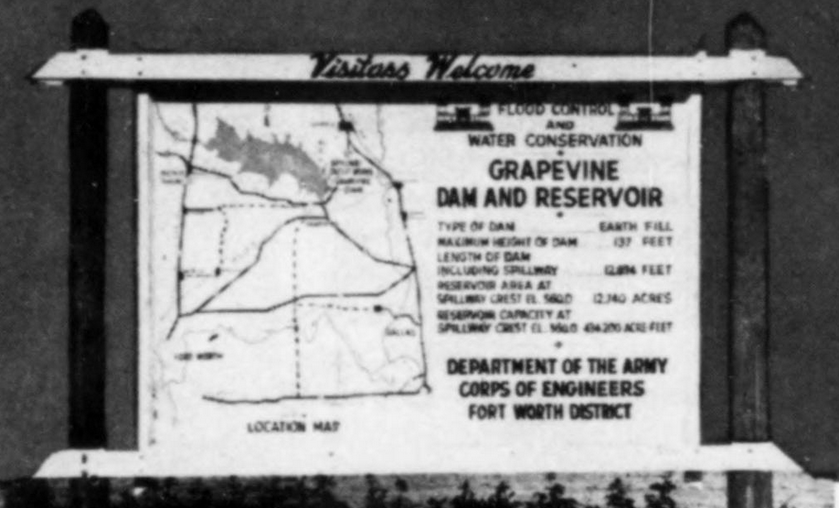
Icy weather hit the dam area on January 5, 1950, temporarily halting construction. J. W. Mosley was just a week away from finishing the raising of the dam’s embankment, but since most contractors were ahead of schedule, the weather would not affect their deadlines.
On January 18, the government hiked its land purchases for the four Trinity lakes going in near Dallas. At that time it already owned 2,955.53 acres of Grapevine. The “taking lines,” or peak elevations at which the government will take lands, had still not been announced, so the army of speculators and land plungers would have to buy blindly, except for studying the pattern of lands taken by the government. Those persons were chiefly interested in cabin and weekend homesites, recreating building locales and sites for all types of businesses catering to lake visitors. Costly lakeside estates planned by Dallas residents were also held up. More Grapevine land had been recently bought from Mrs. F. P. Wiegers, 160 acres; L. G. Bevans, thirty-two; John H. Williams, eighty, and Kenneth B. and Leon Moore, 140.6 acres.
Construction And Land Buying Continues
The Army Corps of Engineers (ACE) told the House Appropriations Committee in late January that at the current pace, the four principal dams on the upper Trinity River would be completed by late 1951. They stated that land acquisition and relocations of highways and railroads in the Dallas-Fort Worth area would require major outlays of federal funds during 1950 and 1951. The dam was scheduled to be closed in the fall of 1951. Only twenty percent of the needed land had been acquired at the time, but the ACE expected to get all of it by mid-1951. Of the $4,000,000 required for the 1950-1951 fiscal year, $2,138,750 would go to building embankments; $367,000 for removal of Texas & Pacific railroad tracks and Highway 377; $64,200 for relocation of county roads; $22,100 for relocation of telephone lines; $1,225,200 for land purchases; $154,800 for reservoir clearing, and $27,250 for downstream slope protection.
At this point, the dam project was half complete. Contractor J. W. Mosley had completed his contract to move about fifty percent of the dirt for the two-mile embankment. In order to speed up construction, three contracts went out for bidding in mid-February 1950. One was for placing about 3,300,000 cubic yards of earth fill to complete the dam and for placing 123,000 cubic yards of rock to protect the upstream slopes of the embankment from wave action. This contract went to T. L. James & Company and Guilliams Brothers of Ruston, Louisiana. Another was for clearing brush and timber from almost 13,000 acres that would eventually be the lake bottom, which was awarded to Bill Curthy of Des Moines, Iowa, and the third was for grassing the already completed section of the earthen embankment to prevent erosion.
As the two Louisiana firms moved the remaining earth that Mosley left, one hundred workers were pouring concrete for the spillway. The earthen embankment was only half its required height of 137 feet. The two notches it contained were for Denton Creek to pass through; the other was to be the site where water would pass to Dallas and the Park Cities. The control works would be complete in about a year, after which the creek would be closed off. As water began to rise out of the creek, it would climb over former cattle pastures and cotton fields. The rise would be controlled until the earthwork was finished and a layer of stone and sand placed on the dam’s upstream side to prevent damage from wave action erosion.
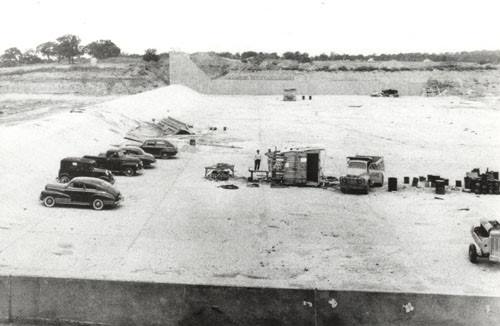
Worth District.
Once this was accomplished, the lake would be ready for filling. How fast it would fill would depend on the weather. From past experience, it was believed that if Denton Creek flooded again, it would fill quickly. Harkening back to the 1908 flood, enough water flowed down the small creek in one day to fill a channel nine feet wide and 150 feet deep from Dallas to St. Louis.
Grapevine banker David Box observed that no houses were available for rent and that new houses were selling as fast as they were built. Moreover, he expected a building boom in the spring. Property around the lake at that time was selling from between $175 and $500 an acre in small tracts, but not enough land was for sale to meet the demand.
In March 1950, Federal District Attorney Warren Moore announced that he had filed condemnation proceedings at Sherman to take title to 5,600 acres behind the Grapevine, Lavon, and Garza-Little Elm (Lewisville) dams. It was the first large-scale court action taken by the government to take those lands. At Grapevine, land buyers for the ACE could not make purchase agreements with owners of ten farm tracts covering 1,300 acres. The work had to be done so quickly, Moore explained, that he had to request two special attorneys to assist him. He expected to see a large number of cases at Sherman because lands needed for the three lakes were in Denton and Collin Counties, part of the Eastern Federal District Court District. The government had to obtain title to an estimated 15,000 acres at Grapevine. At that time, the ACE held title to 2,334 acres there, covering twenty-three tracts. At the same time, per President Harry S Truman’s budget message, the House Appropriations Committee cut the Grapevine project from $4,000,000 to $2,000,000, half of what was allotted for it. Once again, project proponents turned to the Senate to restore appropriations. In Fort Worth, a federal jury awarded Grapevine landowners Mr. and Mrs. W. V. Griffis $5,100 for forty acres of their condemned land. They were originally given $4,633 by a US commission, but after the government appealed and sought to give them $2,800 for the acreage, the award was increased. Many more of these cases were contested throughout and even after dam construction.
In late March, flood control and navigation groups were up in arms over congressional economy proposals that would wipe out $5,000,000 in planning funds for the ACE. Trinity Improvement Association (TIA) general manager John Fouts charged the House Appropriations Committee with being in a plot with President Truman to sabotage the ACE and build up the Interior Department Reclamation Bureau. Such a budget cut would delay the Grapevine project for a year; the original $4,000,000 would have closed the dam earlier and given relief from flood danger. It would also delay the Park Cities’ plans to get water from it.
On May 18, 1950, officers and directors of the TIA viewed construction progress on the four Upper Trinity dams and met with representatives of nearby communities. Work at each site was ahead of schedule; at Grapevine, concrete pouring was ahead by 232 days. During the visit, John Fouts explained his opposition to the federal move to divert the ACE’s functions to the Interior Department’s Bureau of Reclamation based on what he claimed were political reasons and urged his like-minded listeners to communicate with their representatives in Washington. After visiting the Lavon and Garza-Little Elm sites, the Grapevine Chamber of Commerce gave the visitors lunch. Mayor Gordon Tate, David Box, Bill Guest, Floyd Deacon, Henry O. Oatis, and Hugh Millican represented Grapevine.
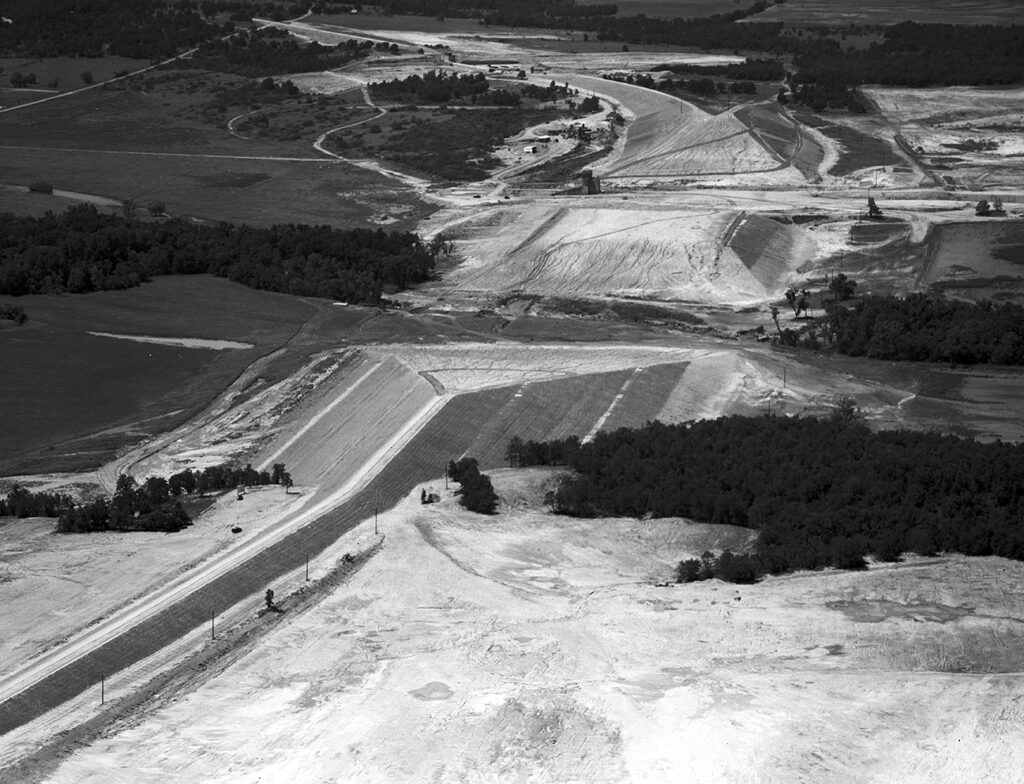
https://library.uta.edu/digitalgallery/img/20150608

Accessed May 11, 2023. https://library.uta.edu/digitalgallery/img/20150607
The way things were running at Grapevine, it looked like the half-finished dam would be able to close in 1951. The Russ Mitchell Company was ahead of schedule on its spillway and outlet works contract, and T. L. James and Guilliams Brothers had just started clearing the reservoir site. E. B. Germany, chairman of the Park Cities Water District and other officials from University Park and Highland Park visited the site in late May and agreed that “We won’t get the water any too soon.” While waiting for word on future water lines of the Grapevine site, Dallas and Fort Worth investors were quite active. Banker David Box said that a farm that sold for $4,000 ten years ago and $7,000 five years ago had just sold for $14,000.
Open House At The Dam
As a part of the 175th-anniversary celebration of the founding of the US Army Corps of Engineers, an open house was held on the Grapevine dam site on June 16, 1950. The public was invited to attend, and banker David Box helped welcome visitors. Traffic was directed by engineers and assistants so visitors would be able to see the site from the best vantage point. All traffic was one-way leaving Highway 121 about one mile northeast of Grapevine and going north over the south section of the dam. It was then directed north across Denton Creek, passing by the outlet works. The tour ended at the north section where the spillway could be seen, after which visitors returned to Grapevine via Bushong Bridge Road. Additionally, John J. Russell, the resident engineer on the project, set up a display at the First National Bank that showed pictures, maps, and charts of the Grapevine lake and other dams being built. Later that evening, a buffet dinner-dance birthday party was given for personnel of the ACE’s Fort Worth district office. Former mayor B. R. Wall was not impressed. “Some kind of a celebration out at the Dam Site,” he wrote cuttingly in his diary, “Did Not go by a damsight.”
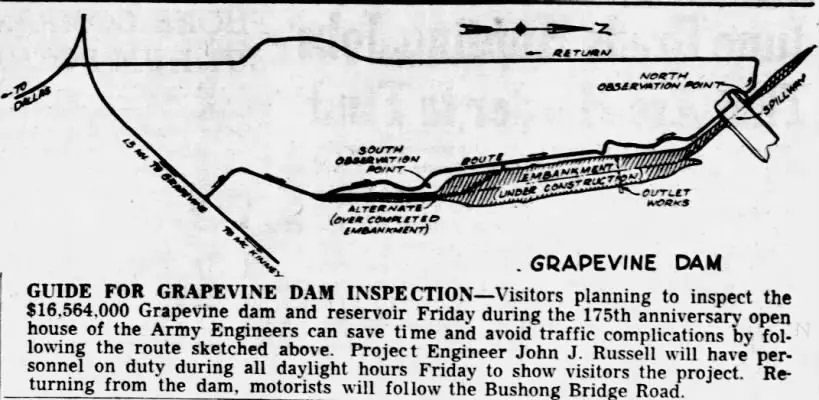
Grapevine gave up 12,800 acres of its best valley farmland for this lake, so we think we certainly should be given a share of the water for municipal use.
David E. Box, President, First National Bank, Grapevine
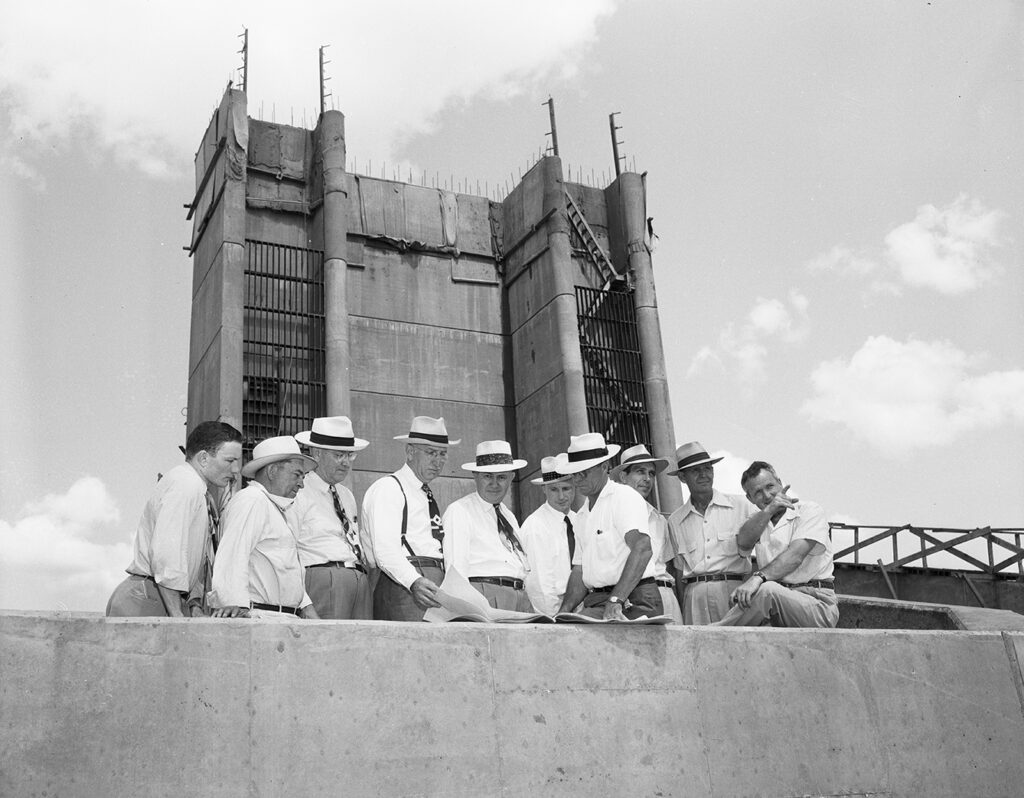
Fort Worth Star-Telegram evening edition, June 16, 1950.
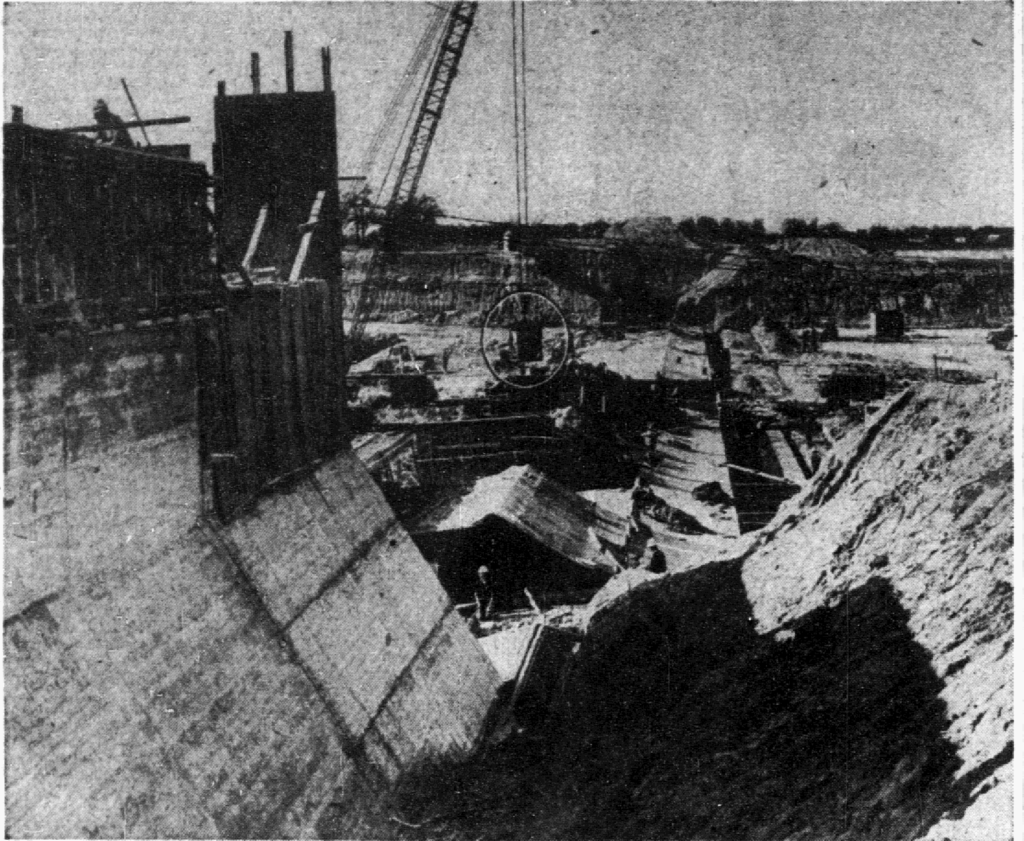
(inside circle) poured one-and-one-half cubic
yards of concrete per minute into the spillway
structure.
Dallas Morning News, February 19, 1950, p. 1.
On June 29, Colonel Delbert B. Freeman of the ACE Fort Worth office reviewed the district’s work at a steak dinner given by the newly-established Grapevine Chamber of Commerce. The group enumerated several of the organization’s objectives, including a domestic water supply from the new lake, and said they would move quickly to apply for a share of it. Colonel Freeman stated that the engineers were also planning full-scale recreation facilities, but they could not be drawn until the reservoir was nearly complete. Funding and local cooperation were also necessary. Banker David Box emphasized that the present Grapevine water supply from three wells would be insufficient if the population doubled or even tripled as a result of the new lake. “Grapevine gave up 12,800 acres of its best valley farmland for this lake,” he argued, “so we think we certainly should be given a share of the water for municipal use.” The Dallas Morning News agreed. Public health concerns alone along the lake shore, it asserted, would necessitate the use of lake water. The law of water rights, it seemed, should be on Grapevine’s side.
Former mayor B. R. Wall was an attorney as well as a Denton Creek landowner and was affected by the dam project in both capacities. As an attorney, he provided legal services for displaced Denton Creek landowner Mrs. Rena Hall through her attorney in Los Angeles, California. From July to December 1950 he worked on getting first, a government contract to buy her land, and second, on successfully getting her due compensation. This is reflected in several of his diary entries during this time. At the same time, he was fighting for compensation for his own Denton Creek property loss, especially regarding gravel, and he did not conceal his frustration with bureaucratic delays and runarounds. “No dice and plenty of excuses and Buck passing,” he wrote in his diary. “We go back one next Tuesday for another stall app[t].” In early August he worked out a deal for $9,500 for his land. By the end of November, he was awarded a final judgement of $9,500 for 761.31 condemned acres. He and his wife Ida were vested with title to all gravel deposits and permitted to remove them until June 30, 1951 if it did not interfere with dam construction or operation. Without comment, he noted in his diary entry of November 30: “Received copy of final judgment Dam case, B.R. Wall land Tannehill Survey.”
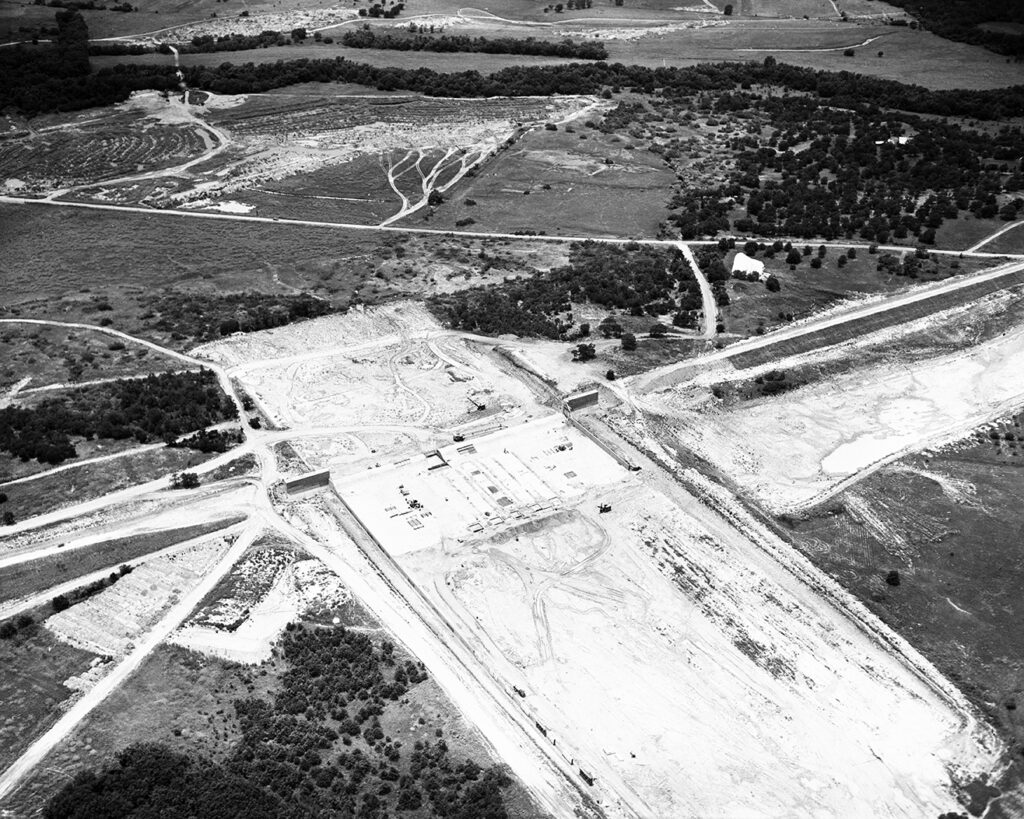
The project’s funding for the 1951 government appropriations bill was assured with the allotment in early August 1950 of $2,000,000, subject to an overall ten percent cut on all non-military items in the bill. TIA general manager John Fouts claimed that work was being accomplished so far ahead of schedule that appropriations for 1951 should be increased for the year ending June 30, 1951, thus getting the three Upper Trinity dams operational one or more years ahead of time. The Grapevine project would then be complete by January 1952. The budget was indeed cut in early October to $1,741,000 but the cut did not significantly affect Grapevine.
By mid-November 1950, the intake tower that would control billions of gallons of water to Dallas and the Park Cities was going up. It contained two gate-controlled discharge conduits, each thirty feet in diameter. On the water side was a huge grill to safeguard against driftwood. When complete it would stand 137 feet high. “This dam will help us like the devil,” said Dallas City Water Superintendent Karl Hoefle. He stated that Dallas was working toward maintaining a water storage capacity of five times the city’s annual requirements, which at that time was 20 billion gallons.
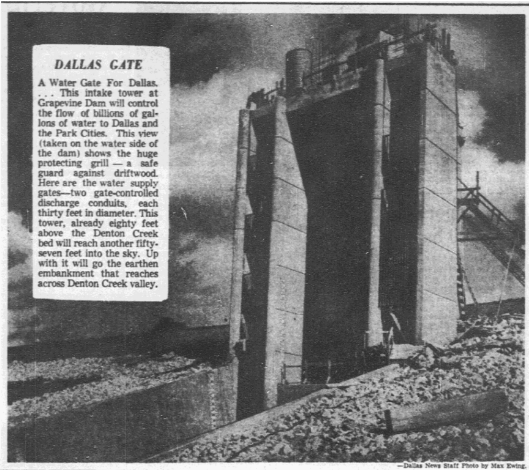
In March 1951, five bids were received for the construction of a 540-foot bridge over Denton Creek, thirteen miles south of Denton. It would be built in the relocation of a section of Texas & Pacific railroad track from the submerged area in the upper part of the Grapevine Reservoir. About mid-April, Colonel Freeman suggested to the Dallas City Council that it advance another $400,000 to the ACE to speed up completion of the dam by six months. With those funds, the dam could be closed in December, at which time Dallas could have an additional water supply. Also during the month, a contract was awarded to F. M. Woodward of Dallas to clear 2,400 acres of land, 1,000 of which was heavily timbered. He had 180 calendar days to complete his work.
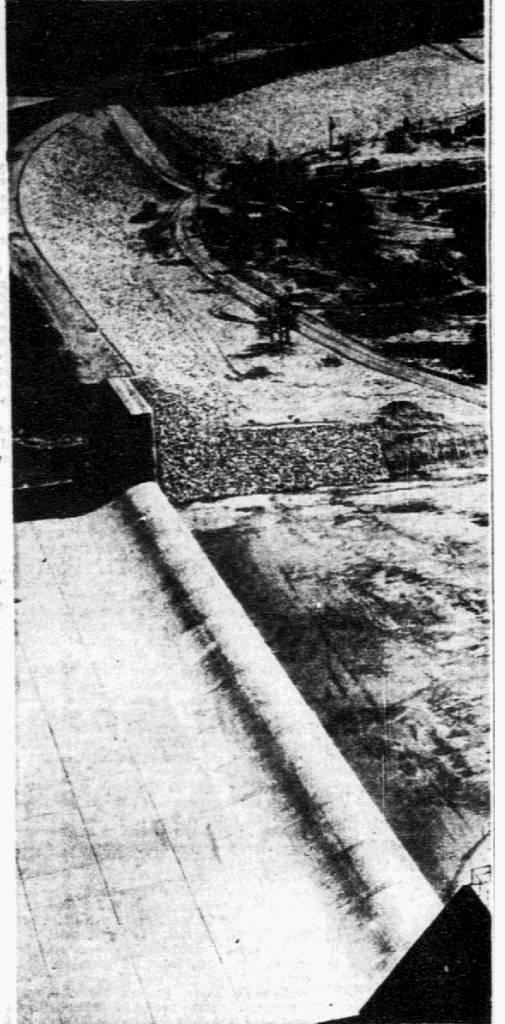
mile earthen embankment.
Dallas Morning News, April 11, 1951
According to former mayor Floyd Deacon, many citizens of Grapevine – those who owned land on Denton Creek as well as those who did not – decided the best thing to be done for the city was “to work out and secure as much as we possibly could . . .” At a special session on June 11, 1951, the City Council voted to proceed to secure water rights from the lake through the ACE at a cost of $25,000 for 1,250 acre-feet of water per year. In hindsight, Deacon said they should have requested 5,000 acre-feet because the city was in a better bargaining position before the lake was finished. At the time, though, they could not have foreseen the amount of future growth Grapevine would experience. A month later, the council agreed to contract with Marvin C. Nichols of Freese & Nichols to represent Grapevine in contacting the State Water Board of Engineers in order to secure their approval of a water supply from the Grapevine Reservoir. The ACE announced at the end of June that the entire project was about sixty-five percent complete, that closure of the final section of the dam would start in early July, and be finished early in 1952. Approximately 1,000,000 man-hours had been worked on the project with no fatalities.
At the beginning of October 1951, 4,000 baby bass were placed in the lake from the Eagle Mountain State Fish Hatchery with permission of the Texas Game and Fish Commission. Waiting to receive them were Mayor Gordon Tate, his son Bill (now the longest-serving mayor of Grapevine), John Hemley, and Oscar Thomas. The mayor was anxious to have the lake stocked as soon as possible so fishing could begin in 1952. Permanent storage of water in the reservoir would also begin at that time. On October 12, Grapevine elected to cooperate with a civic group comprised of interested citizens in securing lakefront property for public use. The mayor appointed Dr. William Wilkerson as chairman, and Bill Yancey, Marjorie Deacon, Floyd Deacon, J. D. Agnew, and representatives from organizations to this committee.
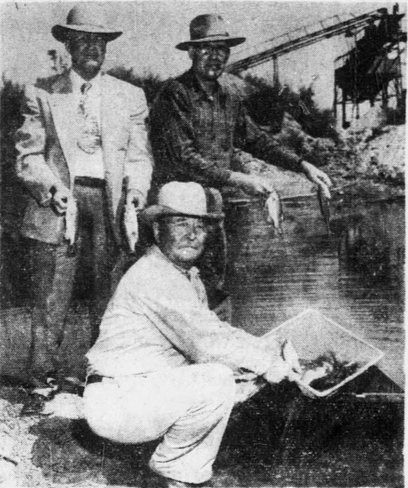
left, and Grapevine Mayor Gordon Tate, top right, held two
bass fish as Superintendent Ben Stone of the Eagle Mountain
State Fish Hatchery released the fish into Lake Grapevine.
The mayor’s son, Bill Tate (not pictured), also assisted.
Fort Worth Star-Telegram, October 3, 1951.
By early November 1951, advertisements anticipating new residents appeared in the Dallas Morning News, offering restricted homesites on the south side of the lake “at fair prices and easy terms,” three and one-half miles from Grapevine. Graveled streets, lights, and gas were already available. In Austin, the State Water Board approved the city’s request on November 12 and granted Grapevine Permit No. 1603 (Application No. 1728), dated November 23, 1951, for the diversion of 1,250 acre-feet of water annually for municipal purposes. Banker David Box, councilmembers S. M. Payne, Hugh Millican, H. M Cosnahan, and City Engineer Marvin C. Nichols attended. Box reiterated that the city’s current three wells would soon be unable to provide sufficient water and sewage services as Grapevine’s population and infrastructure increased over time.
In late November, another dispute arose at the dam site over alleged violations of wage and overtime provisions of the Fair Labor Standards Act by contractors T. L. James & Company and the Guilliams Brothers. In a suit brought by the US Department of Labor, they were accused of repeatedly paying less than seventy-five cents an hour and keeping improper records on overtime pay past forty hours. The case was dismissed in January 1952 after the judge ruled that the workers were not involved in interstate commerce.
The seriousness with which jury trials were undertaken in regard to land valuations was evident in the case of Dallas gravel business owners Elbert R. and Herbert Y. Murff in early December 1951. To demonstrate that the $13,150 award they received was insufficient compensation for eminent domain purposes, they displayed a fifty-pound sandstone, thirteen-foot blood weed that looked like a tree, and Johnson grass almost as tall as a man, to the jury in the US District Court in Fort Worth. The weed and grass specimens were intended to prove fertility of the land, and the stone was to help contend that the land had valuable stone and gravel deposits. US Attorney John Estill claimed the stone and gravel were too deep to be of commercial value because of excavation costs. At about the same time, Fort Worth officials made their case before the State Water Board to set aside 23,750 acre-feet of water from the Grapevine Reservoir that was needed for its east side industrial area.
On March 14, a letter was introduced giving the City’s proposal for furnishing water to the ACE headquarters area on the lake. At a special session on March 31, the Grapevine City Council accepted the recommendation of City Engineer Freese & Nichols to enter into a contract with the ACE in furnishing water to their headquarters area at the dam as provided in Contract #DA 41 443. Under one of the last ACE-awarded contracts, Lander Construction Company of Waxahachie won the bid at the end of March to clear approximately 270 acres of timber with the stipulation that they be allowed to dispose of all cut salable timber.
Recreational Areas Planned Out
In December 1951, a Grapevine committee prepared a request to the ACE for a municipal park site on the lake shore directly north of Main Street. A public hearing set by the ACE was held on April 15, 1952 in the Grapevine High School auditorium to discuss plans for recreational aspects of the reservoir, such as parking, picnicking, drinking water, restrooms, and observation and swimming areas, as well as access roads on government property. One-quarter of the lake’s sixty-mile shoreline was in Tarrant County. Engineers had been deluged with questions from fishermen and other outdoorsmen from Dallas and Fort Worth.
Early in April 1952, Grapevine officials were concerned that they were getting less federal money for relocating roads on the dam site than the Benbrook Lake area was receiving, and they wanted more. About three miles of road were involved. Tarrant County engineer Steve Champeaux explained that because State Highways 114 and 121 completely looped around the Tarrant County section of the lake, passing at no point more than two miles from it, disruption would be less in the Grapevine area. Therefore, Grapevine did not need additional funds for road relocations.
In mid-April at Grapevine High School, the ACE held a public hearing regarding eighteen recreational areas (twelve for initial development) being poised for development on marginal land around the reservoir. Over 200 people attended. The first twelve recreational areas named were Crestview Observation Point; Headquarters Area; Silver Lake Park; Oak Grove Park; Forest Hills area; Meadowmere Park; Walnut Grove Park; Surveyors Landing; Murrell Park; Guess Branch area; Rockledge; and Midvale Park. Also at the hearing were Southern Methodist University, five Dallas-based organizations, and various other non-profit groups, all making requests for lakeside tracts. By the time the dam closed on July 3, over one hundred applications for possible campsites around the lake were being reviewed. No leases would be offered for individual camps because the ACE’s policy was to provide the most recreational space for general public use. Seventy-five percent of the revenue generated by lake-related uses would be returned to the state to be used for public schools and roads in Tarrant and Denton Counties.
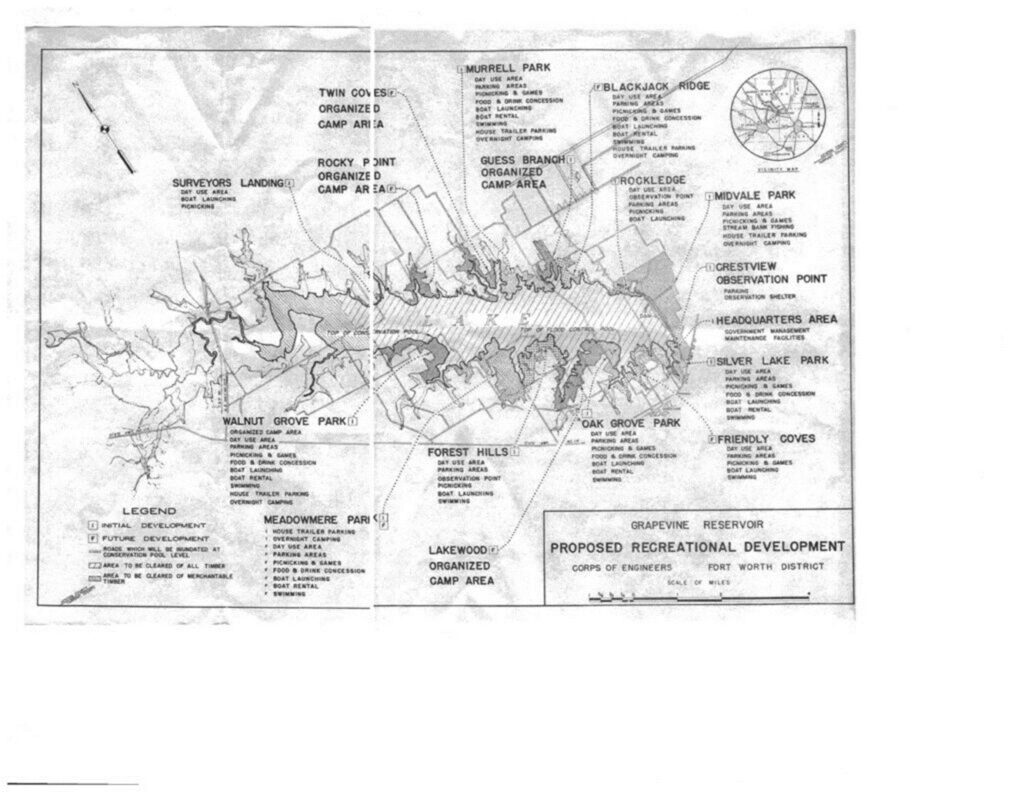
On June 10, in a special session, the City Council agreed to set a minimum wage scale for work on a water line to the lake. It had opened bids for the construction of a 5,900-foot six-inch water line (an extension of the city’s water distribution system) which would furnish city water to the ACE maintenance area at the dam. The contract was awarded to Pelphrey-Basham, Inc. of Fort Worth, who began work within ten days after being notified and would complete the job within forty-five calendar days. By June 12, the ACE had completed the road across Grapevine Dam, which was inspected by the Tarrant County Engineer. The dam was scheduled for closure on or about July 1.
An apparent error on the side of the ACE in June resulted in a suit against the government for damages totaling $2,172, brought by D. K. Barnes of Dallas. He claimed engineers allegedly bulldozed and burned off half of a 115-acre pasture by mistake, resulting in the escape of fifty-seven valuable heifers and the destruction of three-quarters of a mile of fence.
A New Era For Grapevine
On June 19, the ACE issued a public warning to “vacate this area” in which reservoir water would be impounded on or about July 1, “and to remove all livestock and other public property.” The area would be subjected to “rapid rises” for thirteen miles upstream from the dam, “especially in the lower reaches of the reservoir.” This notice appeared in the June 26 issue of the Grapevine Sun. On June 22, Mayor Gordon Tate announced that the dam would close on July 3. Without further comment, B. R. Wall noted in his June 26 diary entry, “Lake will be closed on July 3 – or 4.”
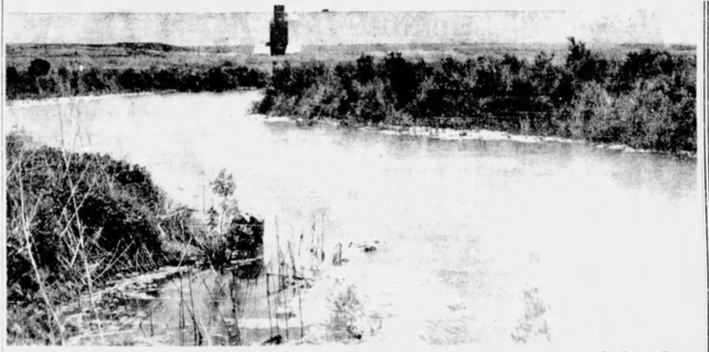
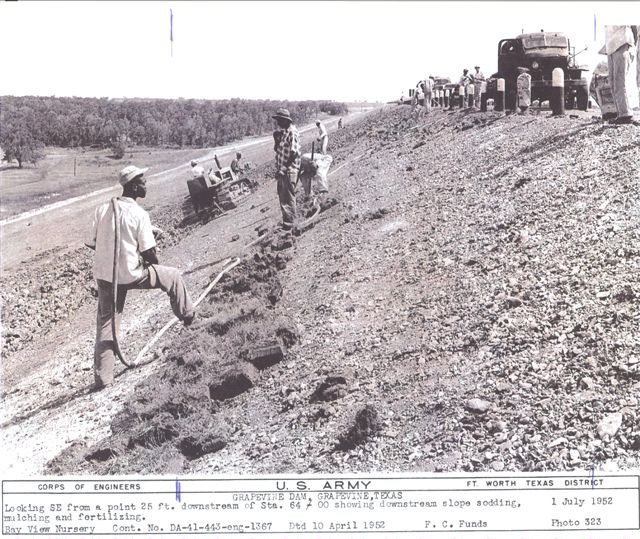
Over one hundred North Texas citizens were invited, including Texas Governor Allan Shivers, Senators Tom Connally and Lyndon Johnson, and Representatives Frank Ikard and Wingate Lucas. Invited guests met at the water tower square in Grapevine and proceeded to the ACE lake office. The ceremony began at 10:30 a.m. on July 3, 1952. The ceremony and tour were sponsored by Grapevine officials, the Grapevine Chamber of Commerce, and the Lions Club of Grapevine, with Mayor Tate in charge. Dallas furnished picnic tables, barbecue pits, and toilets. Mayor Tate welcomed dignitaries and guests at the project office, then introduced Colonel Henry R. Hallock, acting Fort Worth District engineer, who paid tribute to the TIA, Dallas, and the Park Cities for making the project possible, as well as the planners, designers, and project engineers. He posited that it would take about two years’ worth of average rainfall to fill the lake, but if the current drought continued, it would take at least three years to impound the necessary water. Although he stated that “heavy rainfall might fill it in 1953,” by October 1954 the lake was thirty-one feet below normal conservation level. A long drought prevented the conservation pool from filling until May 4, 1957, and the reservoir finally reached a maximum elevation of 560.8 feet on June 6, 1957.
At the outlet works, five men pushed the control tower’s automatic controls which eased the two 24,000-pound conduit gates to the closed position – the mayors of Dallas, University Park, Alderman C. C. English of Highland Park, Grapevine Mayor Gordon Tate, and John W. Carpenter, TIA president. A barbecue at Burt Perry’s farm on the lake shore was served to the invited guests on July 3, and public inspection of the site opened on July 4. The first of the six Upper Trinity projects had been finished. Former mayor Wall, however, was not among the notables. “Opening ceremony at Dam,” he wrote, “not specially invited and did not go.”
Thus ended a campaign that originated in Dallas in 1919, fell by the wayside by 1925, and was reinvigorated in 1930, to harness the soil and water resources of Denton Creek.

Accessed May 11, 2023. https://library.uta.edu/digitalgallery/img/20128765
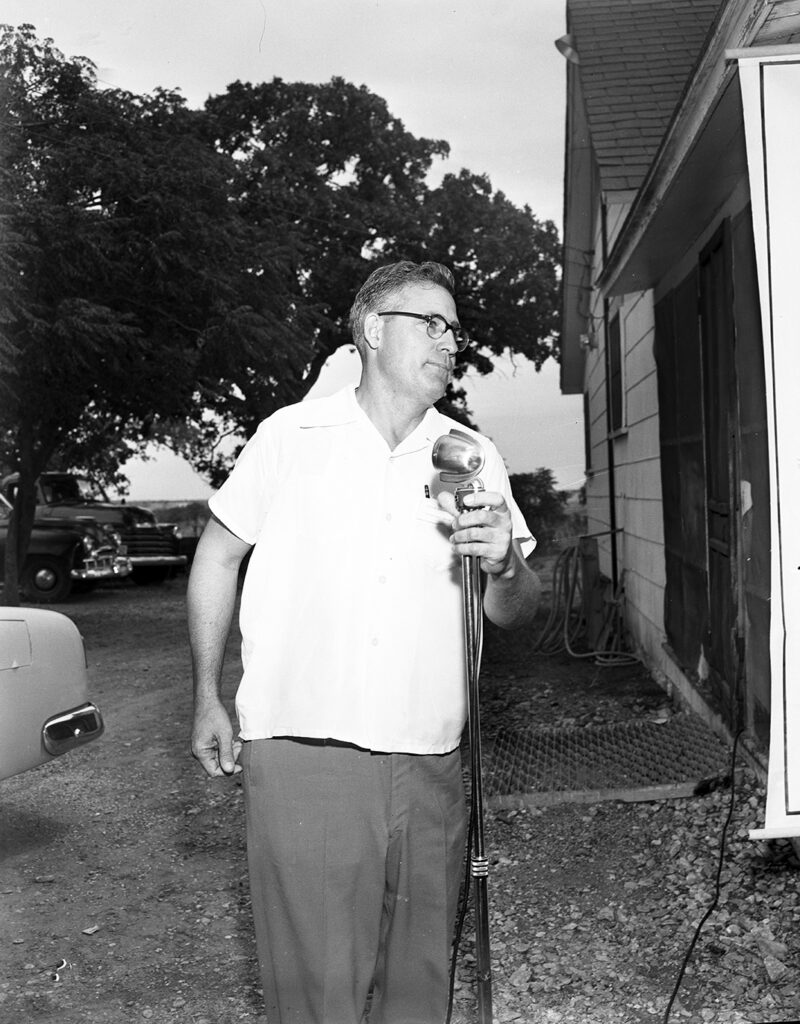
Accessed May 11, 2023. https://library.uta.edu/digitalgallery/img/20128767
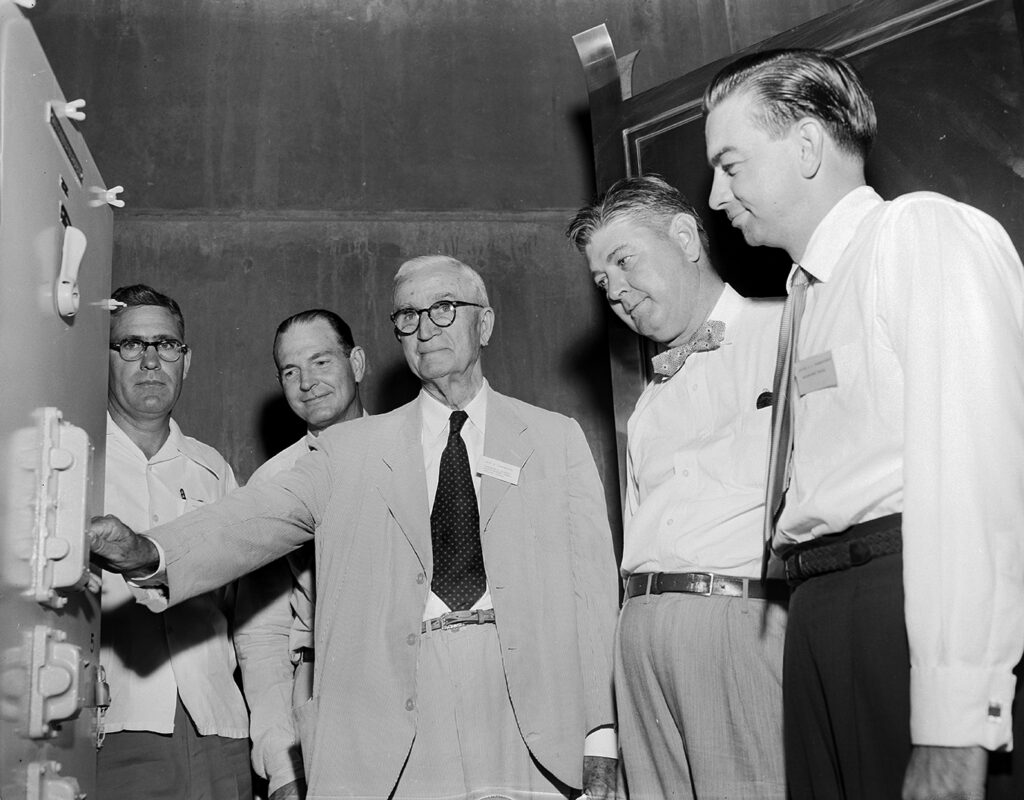
Accessed May 11, 2023. https://library.uta.edu/digitalgallery/img/20128766
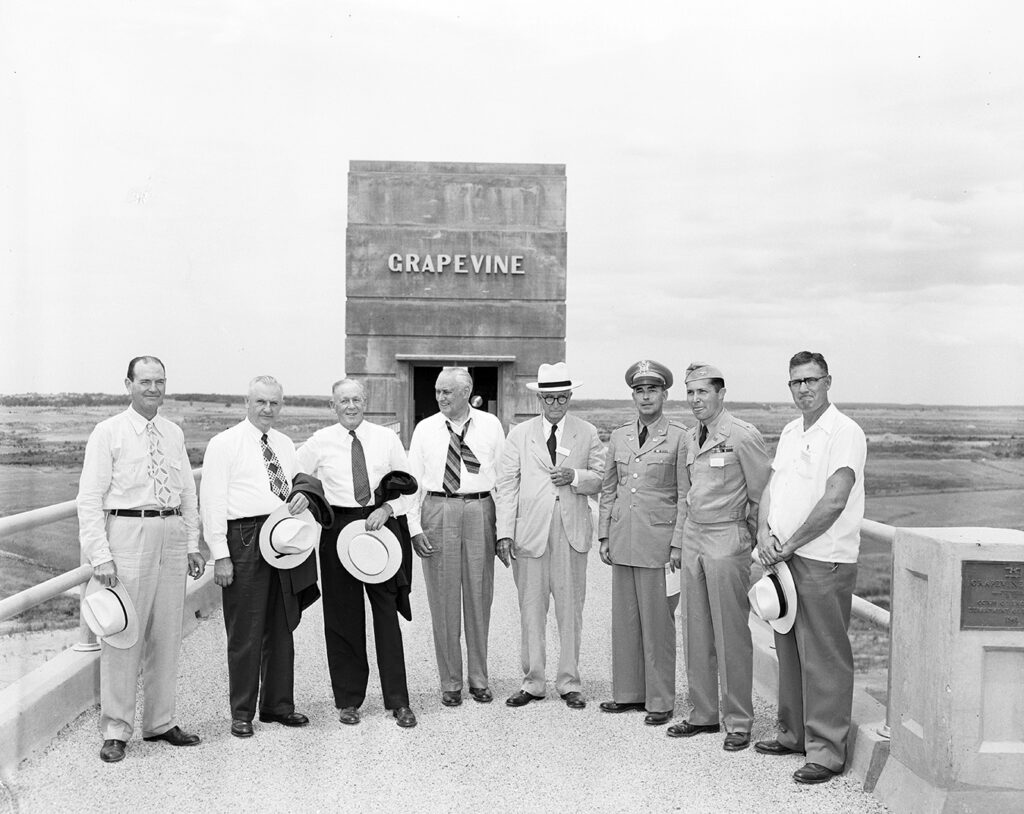
Accessed May 11, 2023. https://library.uta.edu/digitalgallery/img/20128780
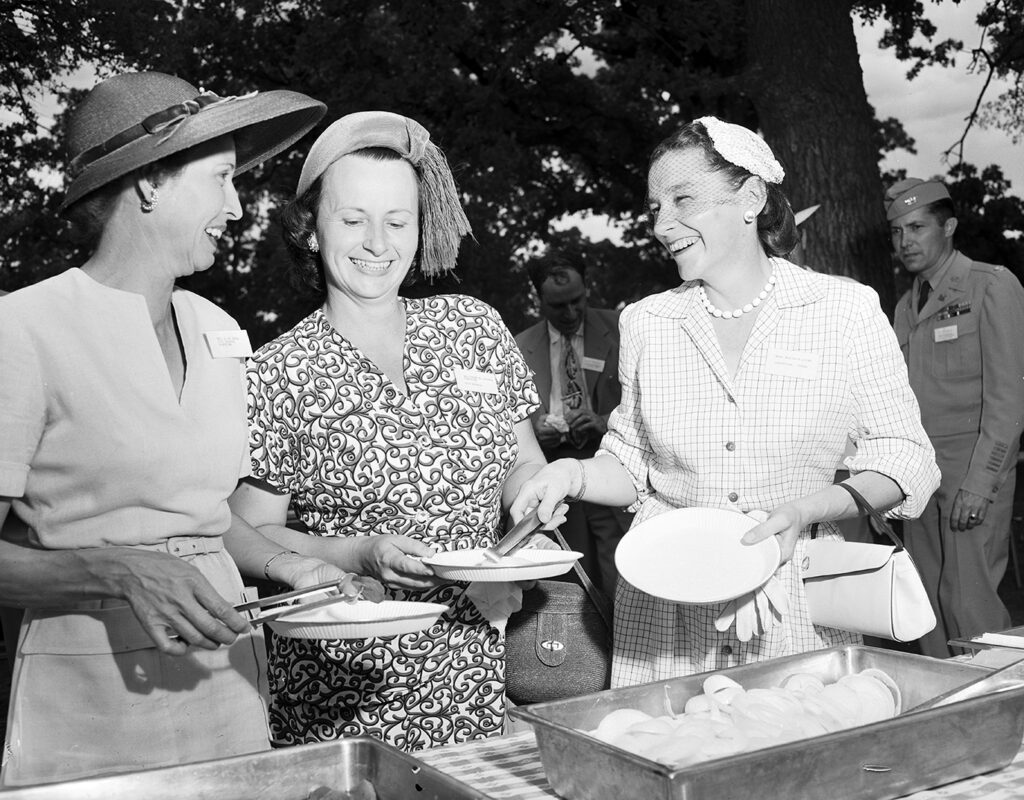
Accessed May 11, 2023. https://library.uta.edu/digitalgallery/img/20128771
John W. Carpenter credited Dallas, the TIA, and other cities and agencies for maintaining a cordial relationship and spirit of cooperation throughout the process, observing that without it, the project would not have been possible. Mayor Gordon Tate proclaimed that a new era for Grapevine had begun.
A new era had also begun for the declining membership of Mt. Horuhm Missionary Baptist Church, said to be the first black church between Fort Worth and Denton, which officially began in September 1905 at 214 East Hudgins Street in Grapevine. Lake construction revived the congregation to a degree because so many blacks arrived from other states to work on the dam and reservoir project. One of them was Henry Jones, who became involved in moving the church to its present location on West Wall Street.
It remained virtually dry from July to December 1952, but enough rain fell so that by the end of May 1953, Grapevine Reservoir began to look like a real lake. In August 1953, Texas employees of the ACE and their families held a picnic there and participated in the many available recreational activities at the site. They also inspected the dam that so many of them worked on. In late 1954, Dallas received permission to begin taking water from Lake Grapevine, but since the lake was not yet at capacity, the city was allowed just enough to dilute the high salt and mineral water it was receiving via Lake Dallas from its Red River water plant.
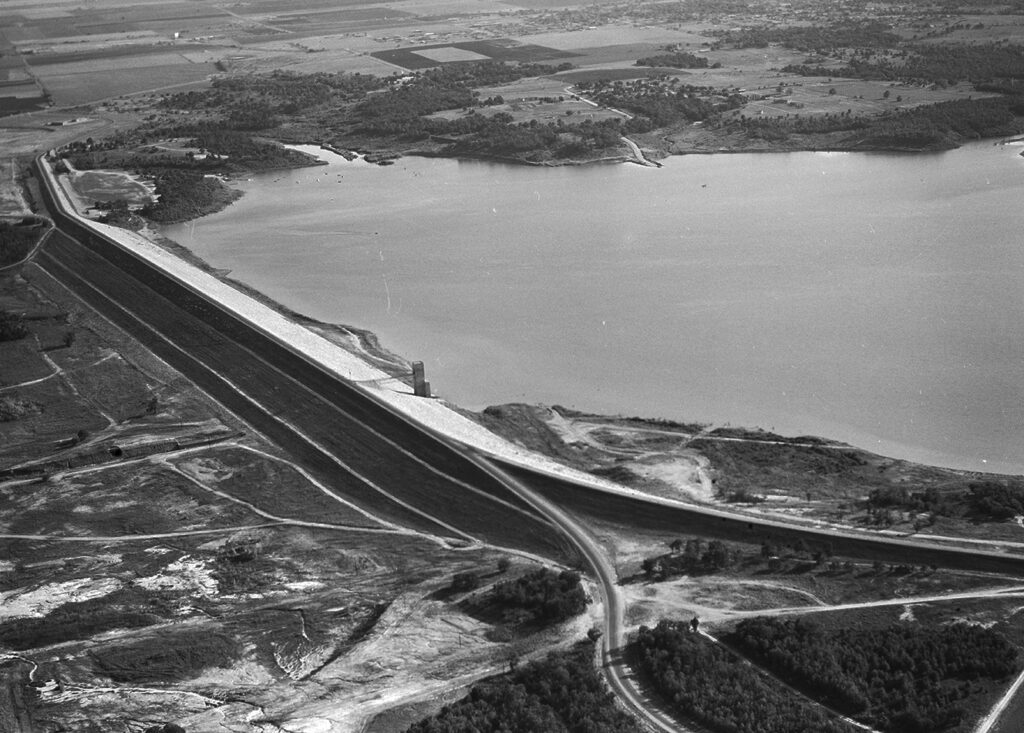
Accessed May 11, 2023. https://library.uta.edu/digitalgallery/img/20140840
“[It] Changed Our City”
Thirty years after the Grapevine Dam and Reservoir project was completed, several Grapevine residents were interviewed about their life experiences in Grapevine, including a few whose long-held lands on Denton Creek were taken. Sisters Irene Dunn Howell and Ela Dunn Coleman recalled that their father Edward Van Zandt Dunn planted an orchard of 500 apple trees on sandy land off Bushong Road, now under the lake. On higher ground he grew plums, peaches, and other kinds of fruits. One hundred sixty-five acres were under cultivation, including some in corn and cotton; half was in fruit trees. About forty acres were flooded by the lake. Catherine Estill Terrill, daughter of Frank T. and Weechie Yates Estill, remembered how her family’s land “was the first land that was taken because that’s where the dam is. We were the first one that they bought.” The Estills owned over 300 acres in the creek bottom by what became part of the spillway.
Vestiges of the dam and reservoir construction still exist beneath the lake, including a giant gravel washer lying on its side near Twin Coves Park, a towering conveyor (possibly still standing somewhere near the lake center), as well as a tractor and two dump trucks all in a row, near what used to be Denton Creek. In the 1960s and 1970s, attempts at extracting these machines were unproductive, and they remain there to this day.
In 2012, Grapevine Mayor William D. Tate, son of former mayor and businessman Gordon Tate, observed that the dam and reservoir project “. . . changed our city. It was the first thing that really began to change us from an agricultural community [to a suburban city] . . . It exposed us as a community, and people started wanting to move here and live here to be close to the lake.”
********************
On Monday, April 28, 1952, a group of eight ladies from Fort Worth, Dallas, and Grapevine had a picnic lunch in Grapevine at the home of Mrs. C. V. Brewer. After lunch they drove around the countryside visiting the old home sites of people who had to move on account of the Grapevine Dam, and gathered flowers from the old homesteads.


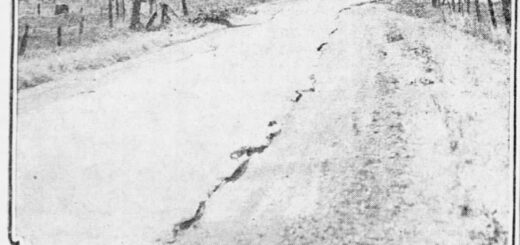

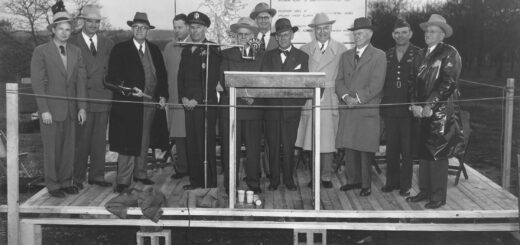
Recent Comments